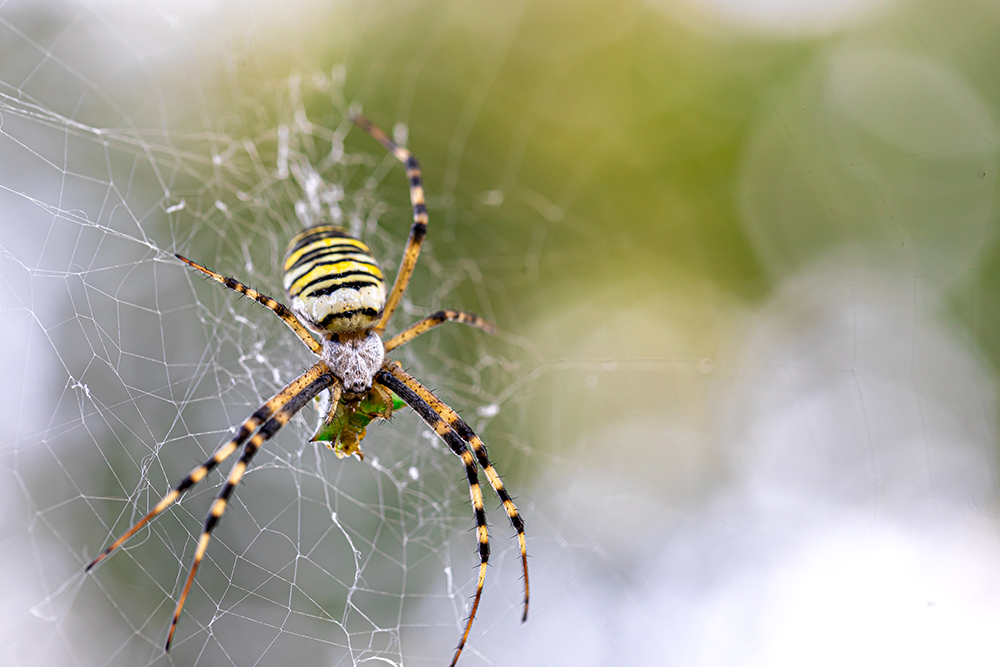Marvel at the Yellow Garden Spider: Nature’s Artisan at Work
If you’ve ever encountered a large, strikingly colored spider accentuating your garden with an intricate web, you’ve likely encountered a Yellow Garden Spider. Known for their vivid colors and distinctive web patterns, these spiders are a fascinating spectacle and beneficial allies in controlling pest populations. Here’s everything you need to know about the Yellow Garden Spider and how to coexist with them peacefully.
Understanding the Yellow Garden Spider
Identification and Appearance:
The Yellow Garden Spider, Argiope aurantia, is also known by several names, such as the black and yellow garden spider, zigzag spider, and writing spider. Females, which can grow up to 1.18 inches, flaunt a brilliant yellow, black, silver, and white pattern on their abdomens, making them hard to miss. The males are considerably smaller, maxing out at about 0.31 inches, and are generally brown.
These spiders are easily recognized not only by their color but also by the distinctive zigzag, or stabilimentum, patterns they weave into their webs. Some believe these patterns help to attract prey or ward off predators.
Habitat and Behavior:
Yellow Garden Spiders are commonly found throughout the United States, especially in gardens, flower beds, and forested areas. They prefer to set their large, wheel-shaped webs up to 2 feet in diameter in areas adjacent to open fields to capture flying insects. These webs are often placed to catch the morning sun, attracting their primary prey — flies, bees, and other flying insects.
The Benefits of Having Yellow Garden Spiders Around
Yellow Garden Spiders are crucial in natural pest control, capturing nuisances like mosquitoes and wasps. Their presence in your garden can help reduce the populations of pests that damage plants and bother humans, allowing for a more pleasant and healthy outdoor environment.
Safety and Precautions
While Yellow Garden Spiders are venomous, their bites are not lethal and typically result in symptoms similar to a bee sting — redness, swelling, and itchiness. They are generally non-aggressive towards humans and will only bite if provoked. Children, the elderly, and those with allergies should exercise caution and avoid handling these spiders.
Managing Yellow Garden Spiders
Indoor Encounters:
If a Yellow Garden Spider wanders indoors, they are likely following prey. These spiders prefer the outdoors, and if found inside, they can usually be safely relocated back to their natural habitat. Ensuring windows have screens and doors are closed can help prevent them from entering.
Outdoor Management:
Consider allowing Yellow Garden Spiders to remain in the garden if they are not in the way. Their environmental benefits often outweigh the cons as long as their webs are not placed where they might entangle or frighten people. For webs built in inconvenient locations like walkways or porches, gently relocating the spider to a less intrusive spot is often the best approach.
When to Call Professionals
Professional exterminators can provide a safe and effective solution in cases where Yellow Garden Spiders are causing significant concern or where their removal is necessary. Companies like Bulwark Exterminating can handle situations where wildlife interaction becomes problematic, ensuring that your home and garden remain comfortable and safe for everyone.
Conclusion
The Yellow Garden Spider is a marvel of nature, providing both aesthetic and ecological benefits to gardens and natural areas. By understanding their habits and benefits, homeowners can appreciate these creatures and their role in the ecosystem. Remember, while they might look formidable, these spiders are often more interested in catching their next meal than interacting with humans, making them a harmless and helpful neighbor in your garden.





